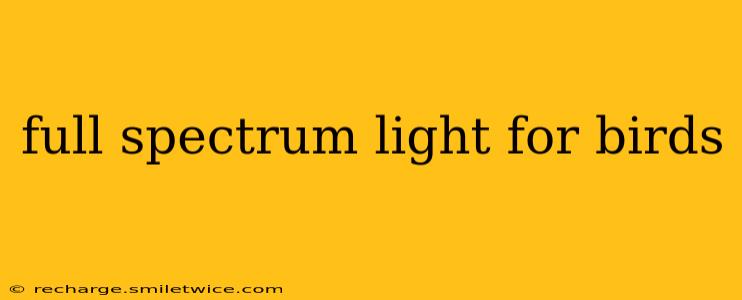Full spectrum lighting is becoming increasingly popular among bird owners, promising a healthier and happier life for their feathered friends. But what exactly is full spectrum light, and does it truly benefit birds? This comprehensive guide delves into the world of avian lighting, exploring the advantages, potential drawbacks, and how to select the best full spectrum bulbs for your birds.
What is Full Spectrum Lighting?
Full spectrum lighting mimics natural sunlight, encompassing the entire visible light spectrum, including ultraviolet (UV) rays. Unlike regular incandescent or fluorescent bulbs, full spectrum lights emit a wider range of wavelengths, more closely resembling the light birds experience in their natural habitats. This broader spectrum includes UVA and UVB rays, crucial for avian health and well-being.
Why is Full Spectrum Lighting Important for Birds?
The benefits of full spectrum lighting extend beyond simply brighter illumination. These lights play a vital role in several aspects of avian health:
- Vitamin D3 Production: UVB rays are essential for birds to synthesize vitamin D3, vital for calcium absorption and strong bones. A deficiency can lead to metabolic bone disease (MBD), a severe and often fatal condition.
- Improved Feather Quality: Full spectrum lighting contributes to vibrant feather color and overall plumage health. It can reduce dullness and improve the condition of molting birds.
- Enhanced Breeding Behavior: In some species, appropriate lighting can stimulate breeding behaviors, promoting successful reproduction. The timing and intensity of light are crucial factors here.
- Boosted Immunity: Studies suggest that exposure to full spectrum light can support a stronger immune system in birds, making them more resistant to disease.
- Increased Activity and Wellbeing: A more natural light environment can lead to increased activity levels, more natural behaviors, and an overall improved sense of well-being for your bird.
What are the Different Types of Full Spectrum Bulbs?
Several types of full spectrum bulbs are available for avian use:
- Compact Fluorescent Lamps (CFLs): These energy-efficient bulbs offer a good balance between cost and effectiveness. However, their lifespan is generally shorter than LEDs.
- Light Emitting Diodes (LEDs): LEDs are long-lasting, energy-efficient, and produce less heat than CFLs, making them a popular choice for bird owners. Look for LEDs specifically designed for birdkeeping.
- UVB Bulbs: While not strictly "full spectrum," UVB bulbs specifically target the UVB wavelengths critical for Vitamin D3 synthesis. These are often used in conjunction with full-spectrum bulbs.
How Long Should Full Spectrum Lights Be On for Birds?
The duration of light exposure depends on the species and the bird's natural habitat. Researching the specific needs of your bird species is crucial. Generally, 10-12 hours of light followed by 12-14 hours of darkness is a good starting point for many birds, mimicking natural daylight cycles.
Are There Any Potential Drawbacks to Using Full Spectrum Lights?
While full spectrum lighting offers significant advantages, there are some points to consider:
- Heat Production: Some bulbs, especially older models, produce more heat than others. Ensure proper ventilation to avoid overheating the bird's enclosure.
- Cost: High-quality full spectrum bulbs can be more expensive than standard bulbs.
- UVB Bulb Degradation: UVB bulbs lose their effectiveness over time. Always check the manufacturer's recommendations for replacement.
What Type of Full Spectrum Light is Best for My Bird?
The best type of full spectrum light depends heavily on the species of bird you own and their specific lighting needs. Consult with an avian veterinarian or an experienced bird breeder to determine the best option for your pet. Consider factors like the size of your bird's enclosure, the bulb's lifespan, and energy efficiency when making your decision.
By carefully considering the type of bulb, its placement, and the duration of light exposure, you can provide your bird with the optimal environment for a long, healthy, and happy life. Remember, responsible bird ownership includes providing the best possible care, and full spectrum lighting plays a significant role in achieving this goal.
